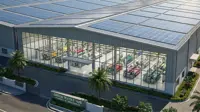Gartner’s predictions for IT organisations and users in 2008
By Our Corporate Bureau | 31 Jan 2008
Bangalore: Gartner, Inc. has highlighted 10 key predictions of events and developments that will affect IT and business in 2008 and beyond.
The predictions highlight areas where executives and IT professionals need to take action in 2008. The full impact of these trends may not appear this year, though executives would need to act now, so that they can exploit the trends for their competitive advantage.
"Selected from across our research areas as the most compelling and critical predictions, the trends and topics they address this year indicate a strong focus on individuals, the environment, and alternative ways of buying and selling IT services and technologies," said Daryl Plummer, managing vice president and Gartner Fellow. "These areas of focus imply a significant groundswell of change that may in turn change the entire industry."
These predictions have been selected from more than 100 predictions that Gartner presents and reviews every year. They focus on general technology areas rather than on specific industries or roles. This year's predictions include:
By 2011, Apple will double its US and Western Europe unit market share in computers. Apple's gains in computer market share reflect as much on the failures of the rest of the industry as on Apple's success. Apple is challenging its competitors with software integration that provides ease of use and flexibility; continuous and more frequent innovation in hardware and software; and an ecosystem that focuses on interoperability across multiple devices (such as iPod and iMac cross-selling).
By 2012, 50 per cent of travelling workers will leave their notebooks at home in favour of other devices. Even though notebooks continue to shrink in size and weight, travelling workers lament the weight and inconvenience of carrying them on their trips. Vendors are developing solutions to address these concerns: new classes of Internet-centric pocketable devices at the sub-$400 level, and server and Web-based applications that can be accessed from anywhere. There is also a new class of applications: portable personality that encapsulates a user's preferred work environment, enabling the user to recreate that environment across multiple locations or systems.
By 2012, 80 per cent of all commercial software will include elements of open-source technology. Many open-source technologies are mature, stable and well supported. They provide significant opportunities for vendors and users to lower their total cost of ownership and increase returns on investment. Ignoring this will put companies at a serious competitive disadvantage. Embedded open source strategies will become the minimal level of investment that most large software vendors will find necessary to maintain competitive advantages during the next five years.
By 2012, at least one-third of business application software spending will be as service subscription instead of as product license. With software as a service (SaaS), the user organisation pays for software services in proportion to use. This is fundamentally different from the fixed-price perpetual license of the traditional on-premises technology. Endorsed and promoted by all leading business applications vendors (Oracle, SAP, Microsoft) and many Web technology leaders (Google, Amazon), the SaaS model of deployment and distribution of software services will enjoy steady growth in mainstream use during the next five years.
By 2011, early technology adopters will forgo capital expenditures and instead, purchase 40 per cent of their IT infrastructure as a service. Increased high-speed bandwidth makes it practical to locate infrastructure at other sites and still receive the same response times. Enterprises believe that as service oriented architecture (SOA) becomes common, 'cloud computing' will take off, thus untying applications from specific infrastructure. This trend to accepting commodity infrastructure could end the traditional lock-in with a single supplier and lower the costs of switching suppliers. It means that IT buyers should strengthen their purchasing and sourcing departments to evaluate offerings. They will have to develop and use new criteria for evaluation and selection and phase out traditional criteria.
By 2009, more than one third of IT organisations will have one or more environmental criteria in their top six buying criteria for IT-related goods. Initially, the motivation will come from the wish to contain costs. Enterprise data centres are struggling to keep pace with the increasing power requirements of their infrastructures. And there is substantial potential to improve the environmental footprint, throughout the life cycle, of all IT products and services without any significant trade-offs in price or performance. In future, IT organisations will shift their focus from the power efficiency of products to asking service providers about their measures to improve energy efficiency.
By 2010, 75 per cent of organisations will use full life cycle energy and CO2 footprint as mandatory PC hardware buying criteria. Most technology providers have little or no knowledge of the full life cycle energy and CO2 footprint of their products. Some technology providers have started the process of life cycle assessments, or at least were asking key suppliers about carbon and energy use in 2007 and will continue in 2008. Many others will begin using such information to differentiate their products by 2009, and by 2010 enterprises will be able to start using the information as a basis for purchasing decisions. Most others will start some level of more detailed life cycle assessment in 2008.
By 2011, suppliers to large global enterprises will need to prove their green credentials via an audited process to retain preferred supplier status. Those organisations with strong brands are helping to forge the first wave of green sourcing policies and initiatives. These policies go well beyond minimizing direct carbon emissions or requiring suppliers to comply with local environmental regulations. For example, Timberland has launched a 'Green Index' environmental rating for its shoes and boots. Home Depot is working on evaluation and audit criteria for assessing supplier submissions for its new EcoOptions product line.
By 2010, end-user preferences will decide as much as half of all software, hardware and services acquisitions made by IT. The rise of the Internet and the ubiquity of the browser interface have made computing approachable and individuals are now making decisions about technology for personal and business use. Because of this, IT organisations are addressing user concerns through planning for a global class of computing that incorporates user decisions in risk analysis and innovation of business strategy.
Through 2011, the number of 3-D printers in homes and businesses will grow hundred-fold over 2006 levels. The technology lets users send a file of a 3-D design to a printer-like device that will carve the design out of a block of resin. A manufacturer can make scale models of new product designs without the expense of model makers. Or consumers can have models of the avatars they use online. Ultimately, manufacturers can consider making some components on demand without having an inventory of replacement parts. Printers priced less than $10,000 have been announced for 2008, opening up the personal and hobbyist markets.






















